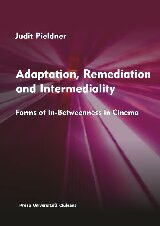Table Of ContentJudit Pieldner
•
Adaptation, Remediation and Intermediality
Forms of In‐Betweenness in Cinema
The publication of this volume was supported
by the Hungarian Academy of Sciences.
Judit Pieldner
Adaptation, Remediation
and Intermediality
Forms of In‐Betweenness in Cinema
Presa Universitară Clujeană
2020
Scientific Reviewers:
Prof. Ágnes Pethő
Assoc. Prof. István Berszán
Consultant Editor:
Assist. Prof. Melinda Blos-Jáni
Descrierea CIP a Bibliotecii Naţionale a României
PIELDNER, JUDIT
Adaptation, Remediation and Intermediality: Forms of In‐
betweenness in Cinema / Judit Pieldner. ‐ Cluj‐Napoca: Presa
Universitară Clujeană, 2020
Conține bibliografie; ISBN 978‐606‐37‐0707‐0
791
© 2020, Judit Pieldner.
Universitatea Babeş‐Bolyai
Presa Universitară Clujeană
Director: Codruţa Săcelean
Str. Hasdeu nr. 51
400371 Cluj‐Napoca, România
Tel./fax: (+40)‐264‐597.401
E‐mail: [email protected]
http://www.editura.ubbcluj.ro/
Table of Contents
Acknowledgements ...................................................................................... 7
Introduction
Shifting Forms of In‐Betweenness in Cinema .......................................... 9
Part I.
Strategies of Screen Adaptation ................................................................. 21
CHAPTER ONE
Medial Equivalences, Functional Analogies?
The Rhetoric of Adaptation
(Tom Jones, Orlando, The French Lieutenant’s Woman) ............................. 23
CHAPTER TWO
Space Construction in Screen Adaptations of Hamlet ........................... 45
CHAPTER THREE
In‐Between the Stage and the Screen.
Representation of Consciousness in Gábor Bódy’s Hamlet .................. 69
CHAPTER FOUR
Remediated Bodies, Corporeal Images
in Gábor Bódy’s Narcissus and Psyche ...................................................... 81
Part II.
Remediation: In‐Between the Immediacy
and Hypermediacy of Cinematic Experience ......................................... 101
CHAPTER FIVE
Remediating Past Images. The Temporality
of “Found Footage” in Gábor Bódy’s American Torso ......................... 103
5
Adaptation, Remediation and Intermediality: Forms of In‐Betweenness in Cinema
CHAPTER SIX
Along the Track of the Effaced Trace in Michael Haneke’s Caché ..... 127
CHAPTER SEVEN
History, Cultural Memory and Intermediality
in Radu Jude’s Aferim! ............................................................................. 149
CHAPTER EIGHT
The Camera in House Arrest.
Tactics of Non‐Cinema in Jafar Panahi’s Films .................................... 169
Part III.
Figurations of Intermediality in Contemporary Cinema .................... 195
CHAPTER NINE
Performing the Unspeakable.
Intermedial Events in András Jeles’s Parallel Lives .............................. 197
CHAPTER TEN
The Anamorphic Perspective In‐Between the Painterly
and the Cinematic in András Jeles’s Sinister Shadow ........................... 213
CHAPTER ELEVEN
Magic Realism, Minimalist Realism and the Figuration
of the Tableau in Contemporary Hungarian and Romanian Cinema .. 227
CHAPTER TWELVE
From Paragone to Symbiosis.
Sensations of In‐Betweenness in Sally Potter’s The Tango Lesson ...... 263
Bibliography .............................................................................................. 287
6
Acknowledgements
With a few exceptions, the essays included in the present volume
are the outcome of research carried out within the framework of two
grant‐funded group projects financed by the Romanian Ministry of
National Education, CNCS – UEFISCDI, Re‐mediated Images as Figurations
of Intermediality and Post‐mediality in Central and East European Cinema
(2013‐2016), project number PN‐II‐ID‐PCE‐2012‐4‐0573, and Rethinking
Intermediality in Contemporary Cinema: Changing Forms of In‐Betweenness
(2017‐2019), project number PN‐III‐P4‐ID‐PCE‐2016‐0418, both led by
Ágnes Pethő, Professor of Film Studies at the Sapientia Hungarian
University of Transylvania, Cluj‐Napoca. The editing of this volume was
finalized within the framework of the second project.
I would like to express my deepest gratitude to Ágnes Pethő for
her inspiring guidance and unconditional support over the years, and
also for supervising and editing the essays. I also thank Melinda Blos‐Jáni
for her assistance in editing the papers for Acta Universitatis Sapientiae,
Film and Media Studies. Many thanks go to the project members, Ágnes‐
Karolina Bakk, Melinda Blos‐Jáni, Hajnal Király, Mihály Lakatos, Katalin
Sándor and Andrea Virginás for the joint achievements resulting from
long‐term cooperation within the projects.
I also express my thanks to Cambridge Scholars Publishing and
Scientia Publishing House, as well as Horea Avram and Claudiu Turcuș,
editors of the scientific journal Ekphrasis, for granting permission to
republish the articles in the present volume. I hereby express my
gratitude to the Hungarian Academy of Sciences and its Regional
Committee in Cluj for supporting the publication of this book.
7
Introduction
Shifting Forms of In‐Betweenness in Cinema
The essays included in this volume are the outcome of my
researches carried out in the past decade in which I have approached
phenomena of contemporary cinema from the perspective of intermedial
relations. This collection brings together multiply overlapping
investigations under the three key terms, adaptation, remediation and
intermediality, which constitute focal points of film studies today.
Therefore, it has been demanding but also stimulating to respond to the
challenge posed by them, and to contribute with colourful mosaics to the
theoretical approach and spectatorial perception of contemporary
cinema. The range of films analysed in this book reflect an endeavour to
approach not only widely known representatives of – mostly European –
art‐house cinema, but also lesser‐known film products born in the Eastern
European region. My interest in Hungarian experimental filmmaking
connects back to the research carried out within the framework of my PhD
studies. My research preoccupations have also taken me beyond the
geocultural boundaries of European film and beyond the borders of
cinema itself through the investigation of thought‐provoking films
belonging to contemporary Iranian cinema. The major concern of these
writings is in‐depth analysis placed in relevant theoretical framework. The
present volume is intended to provide a new context for these film
analyses, in which manifold connection points among both theoretical
aspects and cinematic phenomena may come into view.
The first part of the volume (Strategies of Screen Adaptation) is
dedicated to the theory and practice of screen adaptation. The
9

